Introduction
The 510(k) submission process is a pivotal element in the regulatory landscape for medical devices in the United States, providing a pathway for manufacturers to demonstrate the substantial equivalence of their products to those already on the market. This intricate process not only requires a deep understanding of regulatory requirements but also demands meticulous preparation and strategic planning.
By navigating through the essential steps—from determining the necessity of a 510(k) to selecting the appropriate predicate device—manufacturers can enhance their chances of successful clearance.
Furthermore, awareness of the various types of 510(k) submissions and the common challenges faced during the process is crucial for any organization aiming to bring innovative medical devices to market efficiently. This article delves into the nuances of the 510(k) submission process, offering insights and best practices that can guide manufacturers toward achieving regulatory success.
Understanding the 510(k) Submission Process
The 510 k pathway serves as an essential regulatory route created by the U.S. Food and Drug Administration (FDA), allowing medical equipment producers to show that their product is significantly comparable to a legally marketed item, referred to as a predicate item. This 510 k pathway is particularly essential for products that do not necessitate premarket approval (PMA). The process encompasses several critical steps:
-
Determine if your apparatus requires a 510(k): Generally, most Class II instruments will require a 510(k) submission, whereas Class I instruments are typically exempt. Notably, preamendment products, which were legally marketed before May 28, 1976, and have not been significantly changed, do not require a 510(k) for marketing.
Prepare required documentation: Comprehensive documentation is vital and should include a detailed device description, intended use, labeling, and performance data.
Experts such as Ana Criado, who holds the position of Director of Regulatory Affairs and possesses extensive experience in regulatory processes, stress that thorough documentation is essential for a successful application. Ana holds a degree in chemical pharmacology and a master's degree in health economics & pharmacoeconomics, which further underscores her expertise in this area.
-
To submit your application via the 510 k pathway, it must be directed to the FDA, where the provided information will be meticulously reviewed to ascertain substantial equivalence.
-
Await FDA response: The FDA typically replies within 90 days, granting clearance if the application meets all necessary criteria. Katherine Ruiz, an expert in Regulatory Affairs for medical devices, advises manufacturers to ensure they are using recent predicates to enhance the likelihood of success.
Katherine's background as an industrial microbiologist and her master's degree in Quality Management and Integrated Systems lend credibility to her insights.
Understanding these steps is imperative for ensuring a smooth process. For instance, expert advice emphasizes the necessity of using recent predicates and ensuring thorough documentation to enhance the likelihood of a successful proposal. In fact, as noted by industry specialists,
If your apparatus is definitely Class II and there’s really no substantial equivalent at all - which can happen if you have a really innovative medium-risk item - you’ll have to go down the de novo route < (Qualio).
Furthermore, the case study titled 'Top Tips for Successful 510(k) Submissions' highlights best practices, such as maintaining a clear connection between the device's intended use and the predicate's characteristics, which can significantly influence the result of the process. Furthermore, it's worth noting that the average costs associated with third-party implantation testing can exceed $100,000, further underscoring the importance of a well-prepared application. By familiarizing yourself with the Star format and adhering to these guidelines, you can significantly reduce delays and improve your chances of a favorable outcome in the 510 k pathway for FDA clearance.
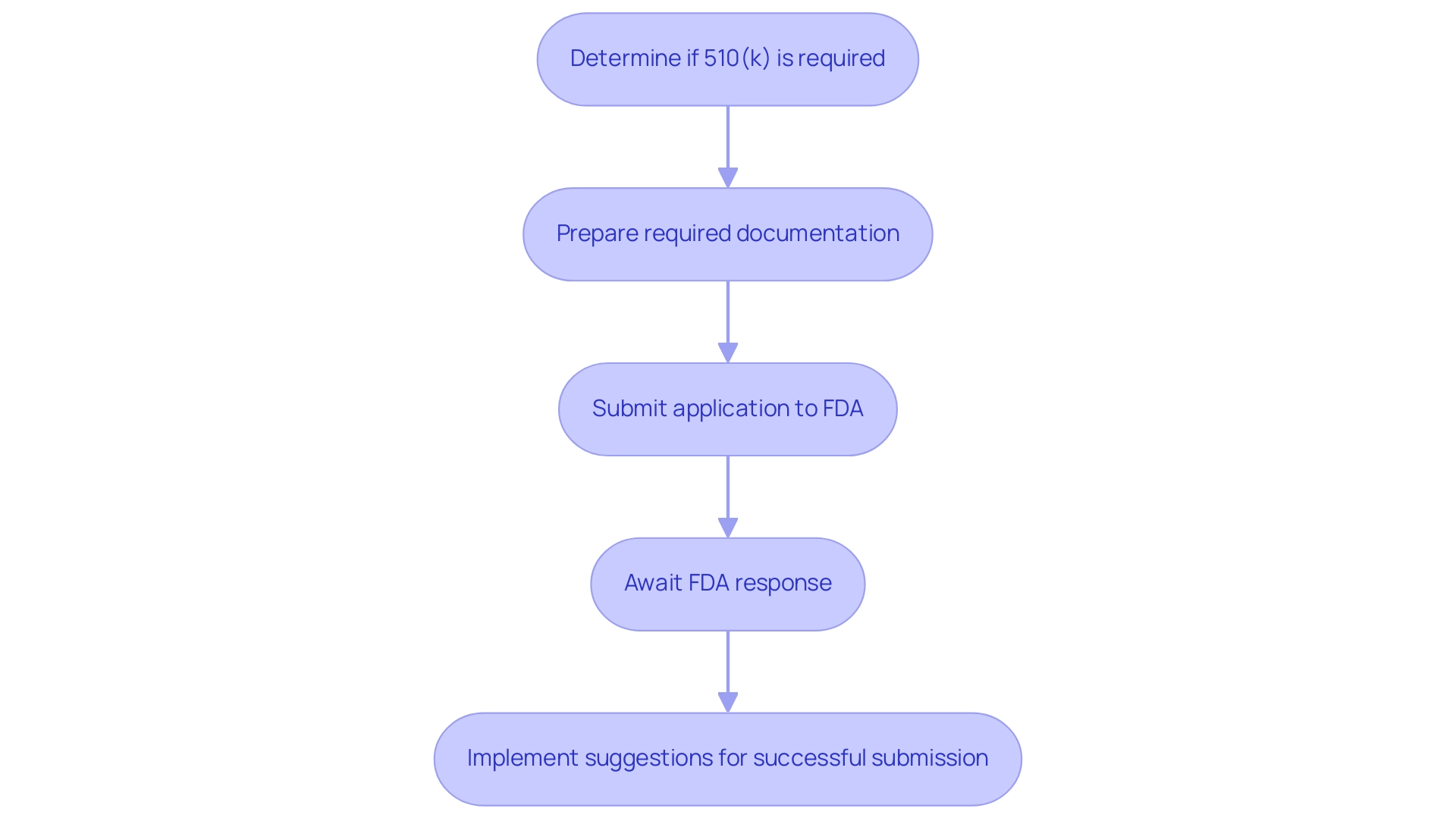
Exploring the Different Types of 510(k) Submissions
Comprehending the various kinds of filings under the 510 k pathway is essential for manufacturers maneuvering through the FDA approval environment. The primary entry types include:
- Traditional 510(k): This is utilized for products that demonstrate substantial equivalence to existing, legally marketed items. It typically involves a comprehensive review process.
- Abbreviated 510(k): This pathway is designed for products that adhere to specific FDA guidance documents or recognized standards, allowing for a more streamlined submission process. This can significantly reduce the time and resources required for approval.
- Special 510(k): This category is relevant for modifications made to existing items, provided these changes do not affect the item's safety or effectiveness. It facilitates a quicker review for minor adjustments while ensuring compliance with existing standards.
- De Novo Classification Request: This option is intended for novel items that are classified as low to moderate risk and lack a predicate. It allows these products to be marketed based on a new classification rather than relying on an existing item as a benchmark.
Additionally, it is important to consider preamendment items, which are those legally marketed before May 28, 1976, that have not been significantly changed. These instruments are exempt from 510(k) requirements as long as they maintain the same intended use, effectively allowing them to be marketed without a 510(k) filing. For instance, products that meet the criteria as preamendment are regarded as grandfathered, offering manufacturers a route that avoids the conventional application processes.
By thoroughly grasping these application types and the effects of preamendment products, manufacturers can strategically choose the most suitable route in the 510 k pathway, which is crucial for attaining successful results. Recent statistics indicate that the FDA typically makes a substantial equivalence determination within 90 days, emphasizing the importance of timely and accurate entries for all types of 510(k) requests, and linking this timeline to the strategic selection of pathways for these requests.
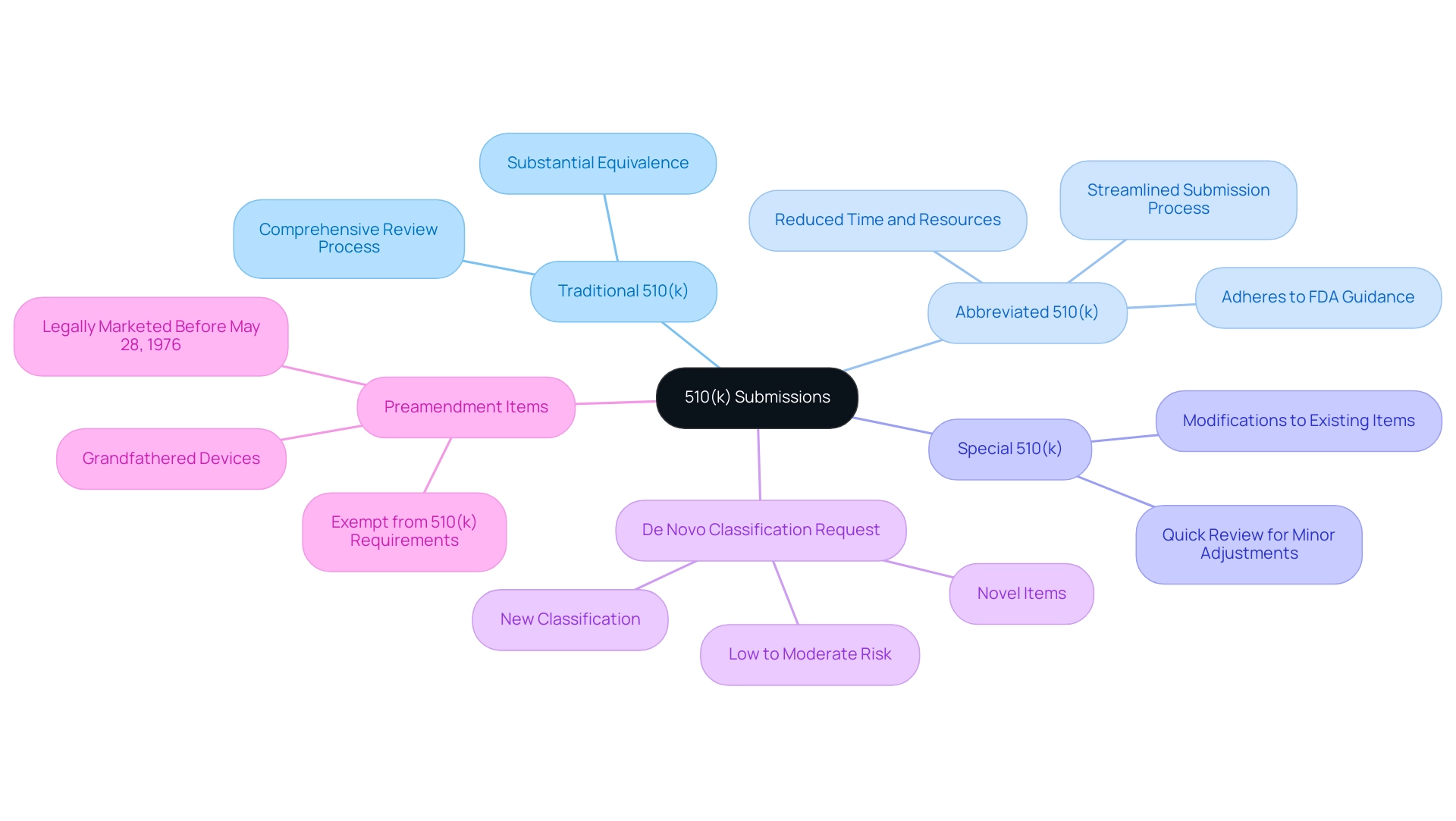
Identifying Your Predicate Device: A Key Step
Identifying a predicate product is a critical step in the 510 k pathway for submission. To ensure a successful selection, follow these comprehensive steps:
- Conduct thorough research: Utilize the FDA’s comprehensive database to locate products that share similar intended uses and technological characteristics. This foundational research is essential for establishing a basis for substantial equivalence.
- Analyze labeling and indications for use: Examine the labeling of the identified predicate products to confirm that their indications for use align closely with those of your item. Consistency in claims is vital; as Jonathan Wacks highlights, the FDA disapproves of a ‘split predicate’ approach, which merges claims from multiple items. The case study titled "Effective Use of Predicate Devices" highlights the necessity of identifying a primary predicate that closely resembles your equipment in terms of indications for use and technological characteristics.
- Evaluate performance data: Conduct a thorough comparison of performance characteristics, focusing on safety and efficacy. This evaluation assists in showing that your equipment meets or exceeds the performance standards of the predicate apparatus.
- Document your findings: Clearly articulate how your apparatus is substantially equivalent to the predicate in your submission documentation. This detailed outline is vital for regulatory reviewers to understand the justification for your application under the 510 k pathway.
- Utilize current statistics: Notably, Turkey has 6 entries in the FDA database, which can provide insights into the competitive landscape and predicate equipment identification strategies.
By thoughtfully choosing a predicate product, manufacturers can greatly improve their 510 k pathway, thus raising the chances of obtaining FDA approval. Recent insights from affairs experts, including Ana Criado, Director of Affairs and CEO of Mahu Pharma, who has successfully navigated complex environments, and Katherine Ruiz, a specialist in medical device regulations who has advised numerous foreign manufacturers, indicate that once a robust strategy is established, the writing of a 510(k) becomes a more straightforward endeavor. Their expertise not only streamlines the filing process but also reinforces the critical importance of a solid regulatory strategy throughout the 510 k pathway, ultimately improving the chances of approval.
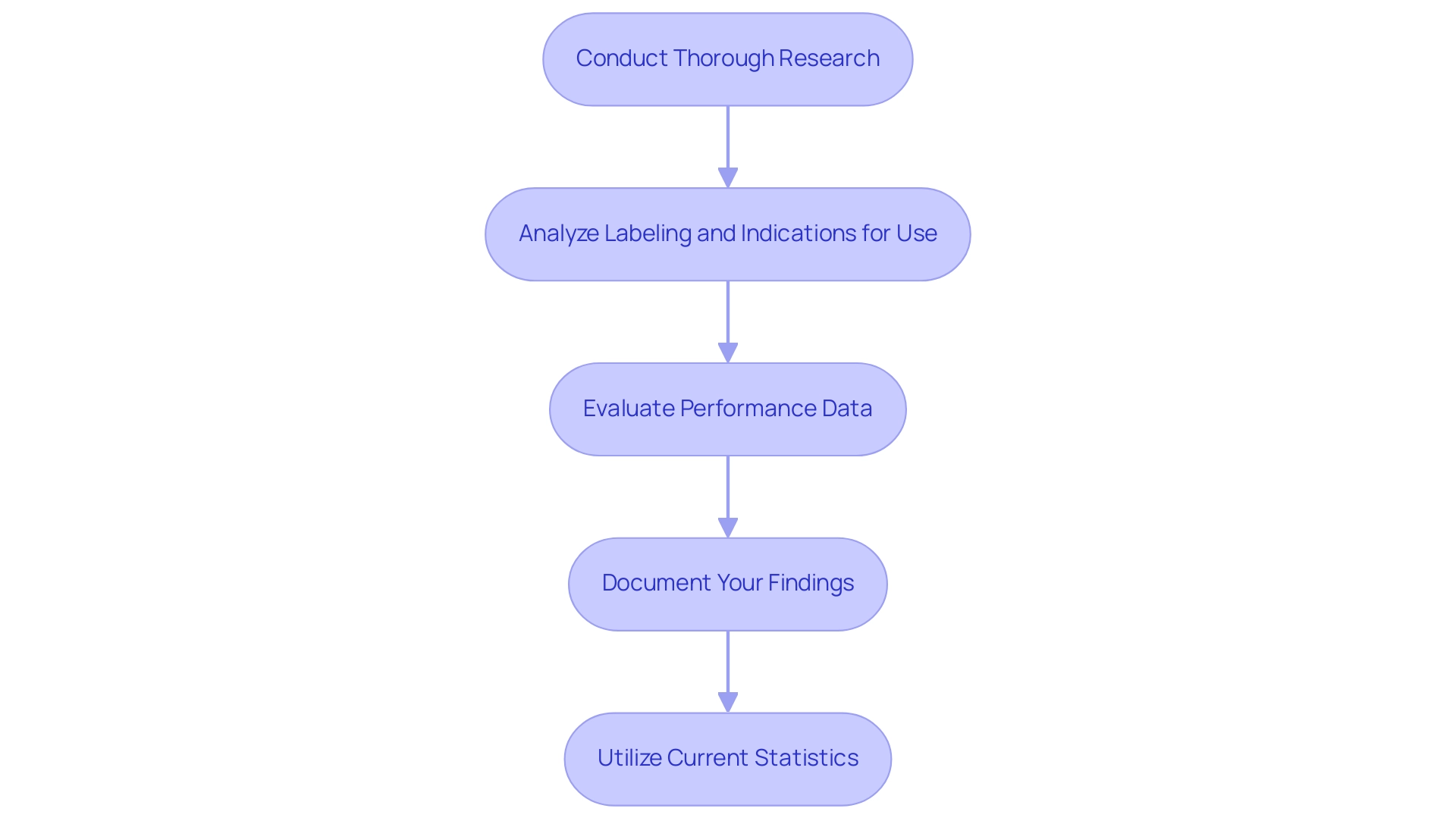
Navigating Common Challenges in 510(k) Submissions
Navigating the 510 k pathway for 510(k) applications is fraught with challenges that can complicate and delay approval. Here are some of the most common issues encountered:
- Insufficient Data: One of the primary reasons for delays in sending is inadequate clinical or performance data. The FDA requires that a device demonstrate no new risks compared to its predicate. To avoid this pitfall, ensure thorough testing and comprehensive documentation of all findings. Notably, rejection rates for submissions through the 510 k pathway due to insufficient data have been significant, underscoring the need for robust data collection. Comprehensive clinical trial management services can aid in collecting the necessary data, including performing feasibility studies that evaluate site capabilities and patient populations, along with compliance reviews to ensure adherence to standards.
- Predicate Equipment Selection Issues: Identifying a suitable predicate instrument is critical. Failure to demonstrate equivalence to a predicate can lead to rejection, as noted by Mike Drues, President of Vascular Sciences, who emphasizes the necessity of establishing this equivalence. Conducting extensive research to identify a suitable match is essential in this regard, which can be supported by local compliance experts like Katherine Ruiz, who specializes in medical device approvals in Colombia.
- Changes in regulations: The oversight landscape is continually evolving, with updates to FDA guidelines and requirements. Staying informed about these changes is crucial for successful entries. Regularly consulting FDA resources and engaging with industry news can help navigate this complexity effectively. Additionally, recent shifts in regulatory priorities, as highlighted in the case study titled "Industry Shift in Regulatory Priorities," reveal that 90% of medical device industry leaders now prioritize US regulatory approval over the EU, indicating the growing complexity of the regulatory landscape. Knowledge of local regulations, such as those from INVIMA in Colombia, can also inform global strategies.
- Incomplete Submissions: Submissions that lack required documentation are prone to rejection. To mitigate this risk, utilize comprehensive checklists that outline all necessary documents and information needed for a complete delivery. It's also important to adhere to proper formatting, including page numbers and eCopy entries, as these details are critical for compliance.
- Reporting and Monitoring: Effective reporting of study status, inventory, and serious and non-serious adverse events is crucial in the context of the 510 k pathway for applications. These reports not only provide transparency but also demonstrate compliance with regulatory requirements. Comprehensive clinical trial management services ensure that all reporting aspects are meticulously handled, thereby supporting a smoother application process.
By proactively tackling these challenges and utilizing comprehensive clinical trial management services, organizations can enhance their application processes along the 510 k pathway. This ultimately leads to a more efficient pathway to 510(k) clearance, ensuring that all regulatory requirements, including those set forth by INVIMA for international studies, are met.
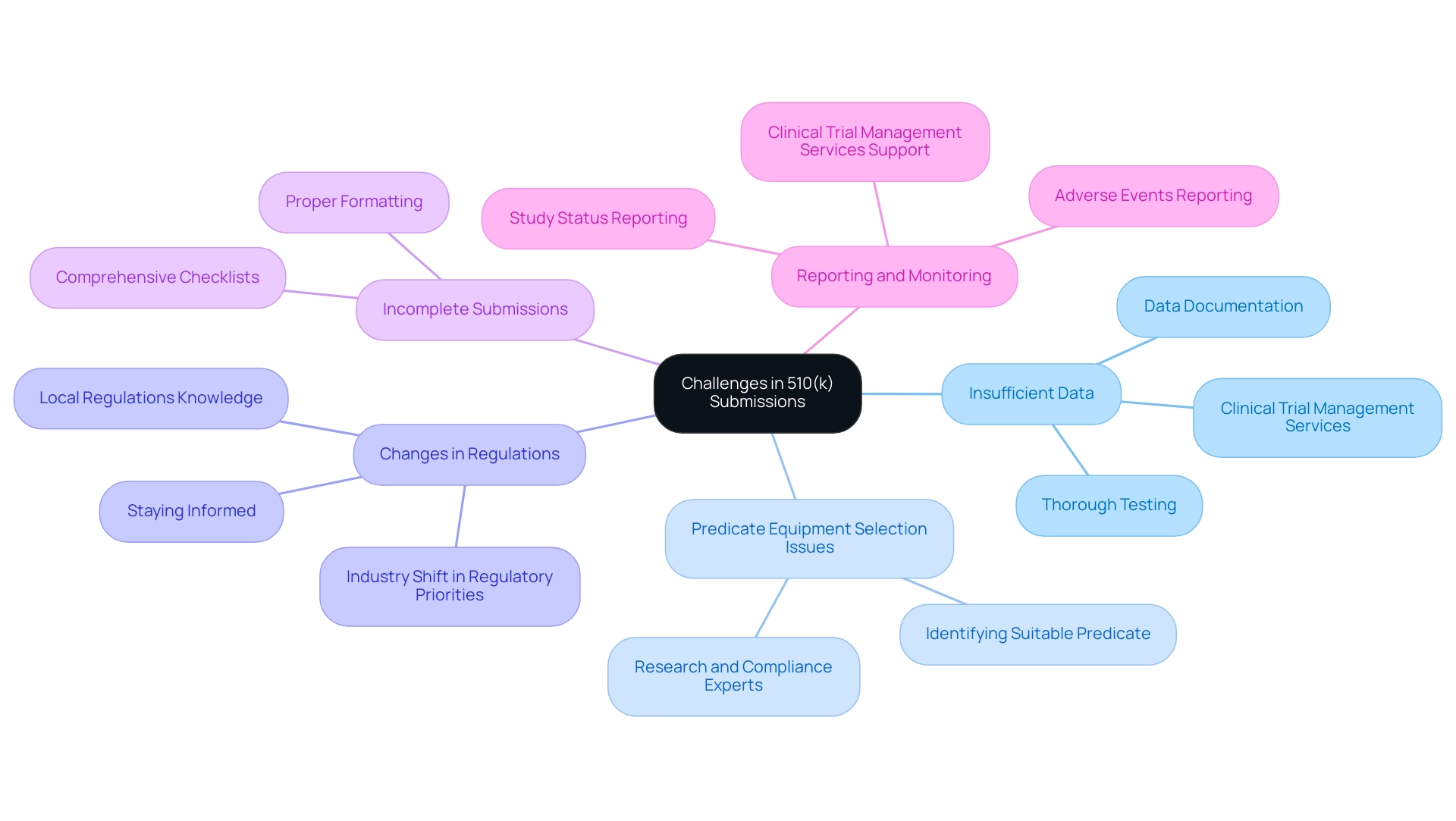
Best Practices for Successful 510(k) Submissions
Achieving a successful 510(k) submission requires adherence to several best practices that can significantly improve the chances of clearance:
- Thoroughly review FDA guidelines: It is essential to familiarize yourself with the most recent FDA requirements and recommendations, as these serve as the foundation for ensuring compliance throughout the application process. Advisory experts like Ana Criado can offer insights into the nuances of these guidelines based on her extensive experience in compliance affairs.
- Engage with the FDA prior to filing: Consider arranging pre-filing meetings with the FDA. Interacting with compliance authorities enables you to address any inquiries or worries about your equipment, possibly easing problems before they occur. As Qualio mentions, "It's not very common, but in certain situations repackers and relabellers in a medical product logistical supply chain could be accountable for a 510 k pathway filing," emphasizing the significance of recognizing regulatory duties. Katherine Ruiz, with her background in medical equipment regulation, can assist in preparing for these discussions effectively.
- Prepare comprehensive documentation: Your entry should include all pertinent information, studies, and comparisons to preceding equipment. This thoroughness not only demonstrates compliance but also supports the safety and effectiveness of your device. Both Ana Criado and Katherine Ruiz, with their extensive backgrounds in compliance matters and biomedical engineering, can provide guidance on the necessary documentation to support your application, ensuring all critical elements are addressed.
- Employ knowledgeable advisors: When needed, seek help from consultants who specialize in the 510 k pathway for 510(k) filings. The expertise of professionals like Ana Criado, who has directed compliance affairs in Colombia and advised international companies, can provide invaluable insights customized to your device’s specific needs. For example, her work with companies like General Electric has involved navigating complex regulatory landscapes, which can be advantageous for your proposal.
- Follow up with the FDA: After your application, it is crucial to maintain communication with the FDA. Proactively addressing any questions or additional information requests can help streamline the review process. Katherine Ruiz's experience in managing inquiries and contributions can be instrumental in ensuring a smooth communication flow.
By implementing these best practices, manufacturers can significantly enhance their likelihood of obtaining successful clearance through the 510 k pathway, particularly considering that 30% of applications in 2022 were not accepted for initial review. For example, preamendment devices, which are those legally marketed before May 28, 1976, that have not been significantly changed or modified, can be marketed without a 510(k) if they maintain the same intended use as when they were first marketed. Engaging with regulatory experts like Ana Criado and Katherine Ruiz and adhering to these strategies can result in a more efficient and effective submission process.
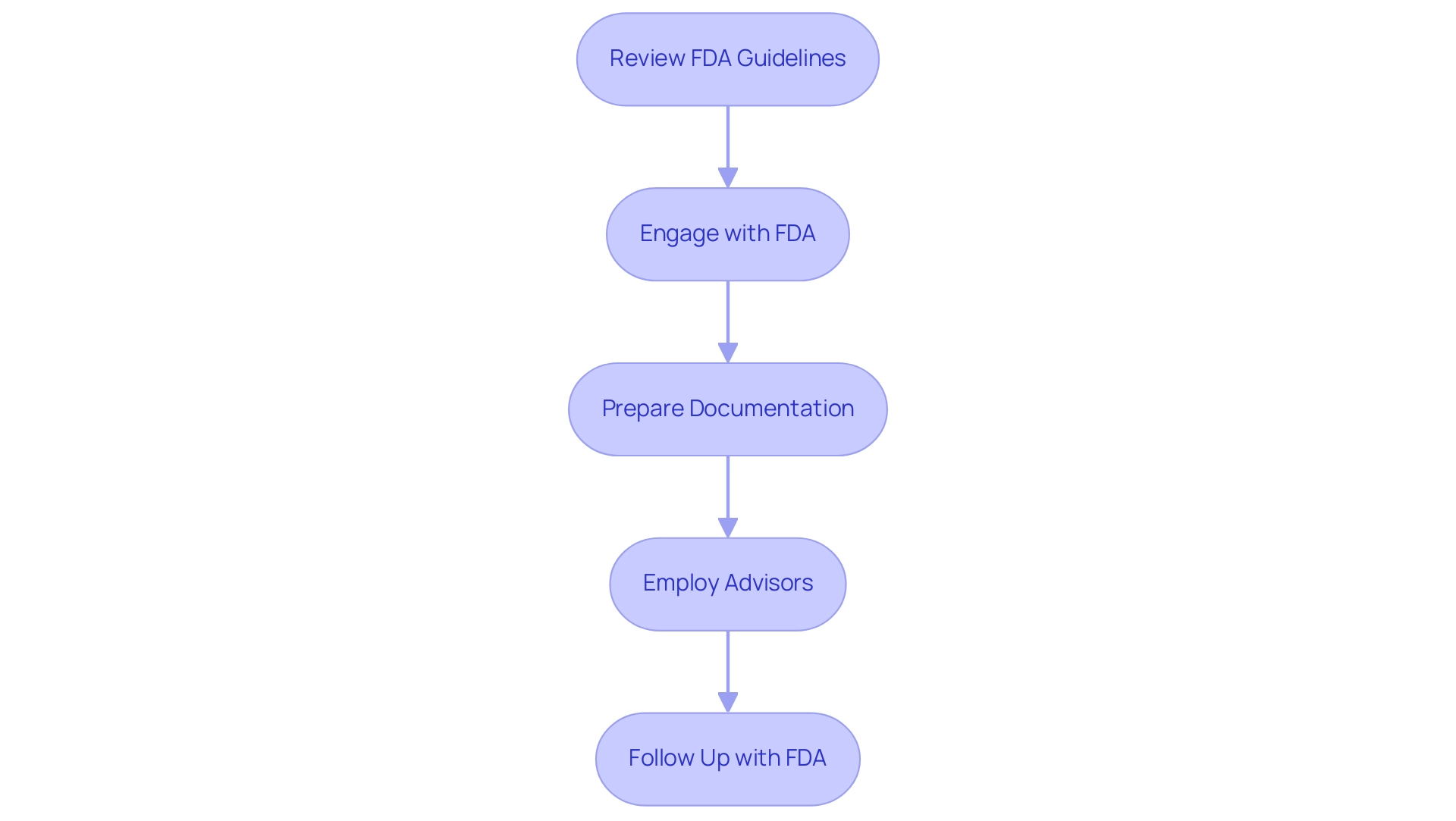
Conclusion
Understanding the 510(k) submission process is essential for manufacturers aiming to navigate the regulatory landscape for medical devices effectively. This article has outlined the critical steps involved in the submission process, including:
- Determining the necessity of a 510(k)
- Preparing comprehensive documentation
- Understanding the different types of submissions available
Each of these elements plays a vital role in enhancing the likelihood of achieving FDA clearance.
Identifying an appropriate predicate device is another crucial step that can significantly influence the success of a submission. Conducting thorough research and ensuring that the chosen predicate aligns closely with the new device's intended use and technological characteristics are imperative. Moreover, addressing common challenges—such as insufficient data, regulatory changes, and incomplete submissions—can help mitigate potential delays and rejections.
Adopting best practices, such as engaging with the FDA prior to submission and leveraging the expertise of regulatory consultants, can further streamline the process. By adhering to these guidelines and strategies, manufacturers can position themselves for success in the 510(k) submission process, ultimately facilitating the timely introduction of innovative medical devices to the market. The combination of careful planning, thorough preparation, and proactive engagement with regulatory authorities will pave the way for achieving regulatory success.
Frequently Asked Questions
What is the 510(k) pathway?
The 510(k) pathway is a regulatory route established by the U.S. Food and Drug Administration (FDA) that allows medical equipment producers to demonstrate that their product is significantly comparable to a legally marketed item, known as a predicate item. It is particularly important for products that do not require premarket approval (PMA).
Who needs to submit a 510(k)?
Generally, most Class II devices require a 510(k) submission, while Class I devices are often exempt. Additionally, preamendment products that were legally marketed before May 28, 1976, and have not been significantly changed do not need a 510(k) for marketing.
What are the steps involved in the 510(k) submission process?
The steps include: 1. Determine if your device requires a 510(k). 2. Prepare required documentation, including device description, intended use, labeling, and performance data. 3. Submit your application to the FDA for review. 4. Await the FDA's response, which typically occurs within 90 days.
What types of 510(k) filings are there?
The primary types of 510(k) filings include: 1. Traditional 510(k) for products showing substantial equivalence to existing items. 2. Abbreviated 510(k) for products adhering to specific FDA guidance documents. 3. Special 510(k) for modifications to existing items that do not affect safety or effectiveness. 4. De Novo Classification Request for novel items classified as low to moderate risk without a predicate.
How should one identify a predicate product?
To identify a predicate product, one should: 1. Conduct thorough research using the FDA database. 2. Analyze labeling and indications for use to ensure consistency. 3. Evaluate performance data for safety and efficacy. 4. Document findings clearly in the submission.
What are common challenges faced during the 510(k) submission process?
Common challenges include: 1. Insufficient data leading to delays. 2. Issues with selecting a suitable predicate. 3. Changes in regulations affecting submissions. 4. Incomplete submissions lacking required documentation. 5. Challenges in reporting and monitoring study status and adverse events.
What best practices can enhance the chances of a successful 510(k) submission?
Best practices include: 1. Thoroughly reviewing FDA guidelines. 2. Engaging with the FDA prior to filing. 3. Preparing comprehensive documentation. 4. Employing knowledgeable advisors for guidance. 5. Following up with the FDA after submission to address any inquiries.
What is the significance of preamendment devices in the 510(k) process?
Preamendment devices, which were legally marketed before May 28, 1976, and have not been significantly changed, can be marketed without a 510(k) if they maintain the same intended use. This offers manufacturers a pathway that avoids conventional application processes.




